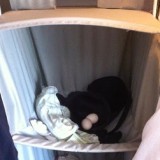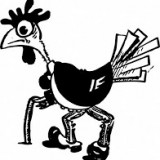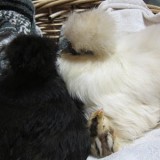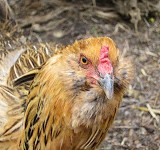We were sent Minnie Rose Lovgreen’s Recipe for Raising Chickens for review, and have been enjoying it so much we thought we’d tell you about it. It was first released in 1975, and this 2009 version is the 3rd edition. It’s a charming little book, paper covered and staple bound, totaling only 31 pages. In fine 70s style, it is handwritten (in neat calligraphy) rather than typeset, and copiously illustrated with pen and ink drawings of hens and chicks.
I’ll say right off the bat that it is not The Definitive Chicken Book. It’s simply too short for that, and its focus is primarily on raising hens and chicks, with a side focus on bantams (because they’re such excellent brooders). As we can’t keep a rooster in our neighborhood, we’ll never see our hens raising chicks–so this information serves mostly to make us wish we lived somewhere where we could let the chickens follow their natural life cycle. However, if your situation allows a rooster, and you’re interested in breeding chickens, this might be a poetical resource that you’d enjoy.
I should add that she doesn’t talk about roosters much at all. They’re invisible players in this story, which is an interesting omission. Perhaps the fact of a rooster being present in the hen yard, doing his work, was so commonplace to her that she didn’t feel the need to mention it. Or perhaps she doesn’t mention breeding details out of delicacy–Lovgreen was born in 1888.

Yes, 1888! That means she wrote this book when she was 87. Her writing comes out of a long life raising chickens, and as such, her advice is wonderfully relaxed and commonsensical–and also joyous. Her love of her hens, and the pleasure she takes in watching them and learning their ways, is clear in every word. She won me over with a quote of the cover: “The main thing is to keep them happy.” That is so true. In fact, that might be all you really need to know.
Above all, its her voice that makes this book so charming. Here’s a sample:
The hen never leaves her chicks for any length of time to get cold. Soon as they commence to “peep peep” like they’re unhappy, she calls them under her. She spreads out her wings and they can all get under her. She spreads her wings real wide. The feathers of her wings are almost like little pages where they can get the air under. They can peek out from her wings, under the feathers, and then get back under her again. When the weather is warmer, the chicks will climb up on the hen’s back and ride piggyback. They have so much confidence in her.
One caveat: this book is $13.00. That’s 42 cents a page. For thirteen bucks you could buy a more comprehensive title, but if you like collecting chicken books, this would be a nice addition to your collection. I like simple books, myself. Books that give you a friendly push in the right direction, but don’t beat you about the ears with lots of confusing details and worrisome warnings. Like all of the home arts, you ultimately learn to keep chickens by keeping chickens, by paying close attention and using your head. Like Lovgreen did.






I love your blog. I’m an urban farmer on the central west coast of Florida. I have a flock of 12, flying under the radar with the county. I don’t have a rooster either, but I do have two Black Stars that are the broodiest broody hens that ever brooded. They have gone broody four times in less than a year. After breaking the broody cycle a few times I decided to let them raise some chicks and so far, since January I’ve raised three clutches. I got fertile eggs from a friend who had a rooster for one clutch and got four chicks that all made it to “adolescence”. My second clutch was Barred Rock eggs from a heritage flock maintained by the Florida State Fairgrounds. This was an extremely vigorous clutch with nine hatchlings and I can see the value of heritage breeds. They are much more vigorous than the standard engineered Rhode Island, Buffs, etc. The last clutch was Arucona eggs I purchased on eBay. I had poor hatching on this and only one viable chick that is now three weeks old.
So if you have broody hens and can get some fertile eggs from somewhere, you can have the pleasure of raising baby chicks the old fashioned way. The broody hen is a true marvel of nature.
One caveat: there is always the risk of introducing disease to your flock if the eggs come from another chicken flock. I don’t think this is a great threat, but it pays to know your egg source and their chicken raising practices.
Thanks, Anon! You are completely right. There are work-arounds if you can’t have a rooster.
This reminds me of a bit of internet trivia–I read an account by this guy in Japan brooded and hatched fertile eggs from the grocery store shelves. Eggs are wonderfully resilient, it seems. But I agree with you–if I were to do it, I’d seek out eggs from heritage breeds, not dodgy supermarket layers.
Our ladies have zero maternal instinct. We’d have to bring in a broody hen to try it–perhaps we could borrow Homegrown Neighbor’s crazy-broody bantam silky?
Interestingly, the author of this book claims that commercial layer feed (which was newfangled for her) interferes with the broody instincts in hens. I’m not sure how it would, but I would believe if they could engineer that possibility, they would, because broodiness cuts production. Lovgreen says it particularly affects standard hens. It interferes with bantams somewhat too, but much less, according to her, and that’s why she keeps bantams as broody hens.
When one of our hens went broody rather than “breaking”her, we went out to the Hollywood Farmers Market and got a couple fertile eggs to put under her. One of them hatched! It was amazing to see them together. Our kids loved it. So now we have a homegrown chicken. We’re lucky and grateful that “Pat” grew into a hen – not a rooster. We were holding our breath for a minute there.
@ Anon #2: What a great story! You’ve got a Homegrown Hollywood Hen (HHH). It must have been so sweet to watch mama hen with her chick.
The folks at Factor e Farm are working on an open-source, DIY egg incubator…I wonder if they’ve ever heard of the bantam.
Your neighborhood doesn’t welcome roosters, but might it be possible for a rooster from a worse/more remote neighborhood nearby to help you out once in a while?
@Joel:
Not to denigrate a worthy open source project, but give me a broody banty over a machine any day. Incubation is just the beginning, after all. After they hatch, the real work begins. Chicks are cute, but man they’re time intensive–and curiously destructive for creatures that weigh 1 oz.–and vulnerable to everything. I say let mama hen do that work.
And LOL the notion of visiting roosters. Wandering studs? We’d be pretty thrilled if we looked out the window and found a rooster strutting around our backyard. I imagine our ladies would be, too. Or did you mean we could borrow a rooster?
chickens raise themselves.